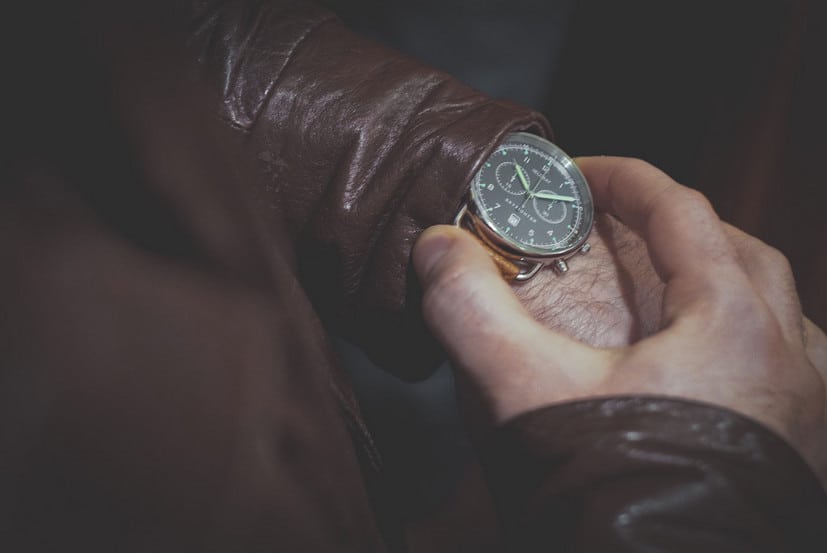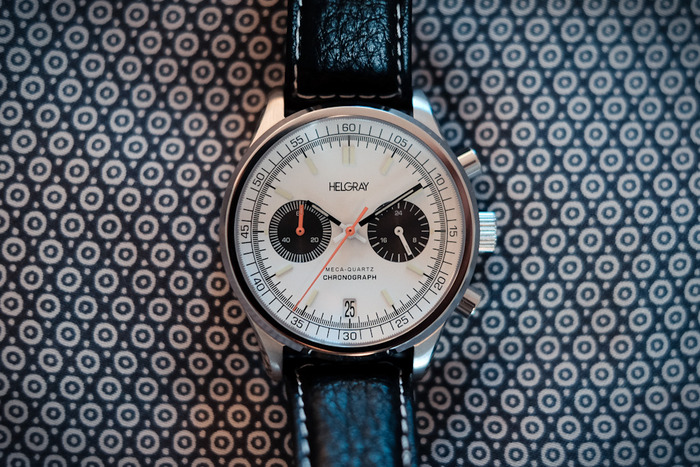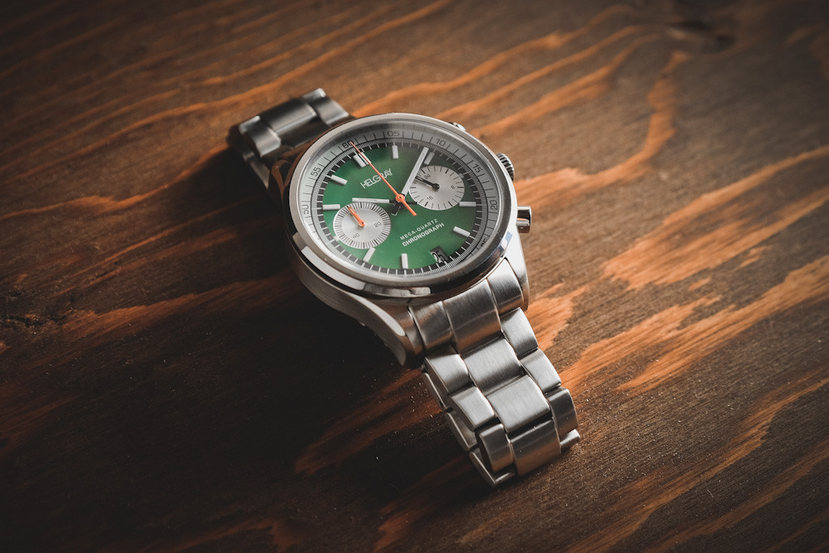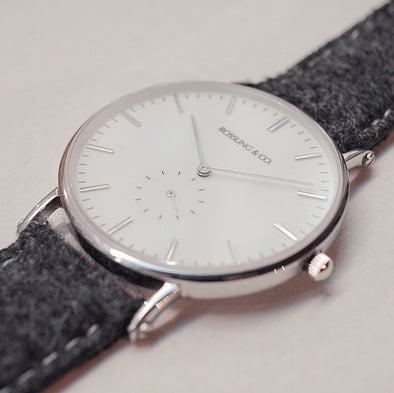The devil is in the details for Nadim Elgarhy, who has been creating his own vocabulary of well-made and affordable watches across three brands with distinct styles. Details such as the meca quartz movement in a chronograph (from the Helgray Silverstone chronograph) to the smooth bezel of a bronze diver (Makara Hawksbill Sea Turtle) to the tweed strap on a slim small seconds hand dress watch (Rossling & Co.), Makara, Rossling & Co. and Helgray are developed with highly focused and very different esthetic parameters.
We’ve reviewed a number of his watches (often started on Kickstarter and discussed on WatchUSeek forums) and have consistently been impressed with Elgarhy’s offerings, which are mostly sub-$500.

Montreal-based Elgarhy has background in engineering as well as marketing and design, the ideal combination to bring concepts to fruition and success in the marketplace. We asked him about his work.
Q: Who and what are your top design influences? What inspires your work?
A: I’m not influenced by any specific artist or designer, or by any particular style. I find inspiration in a wide range of things, from a color scheme observed in the wild to an intricate engineering detail on a mechanical part. I have a very high appreciation for objects that are functional and simple. I find beauty in design where form follows function.
I’m a car enthusiast, and I’m especially fond of vintage sports car and racing. This is where you see some very creative stuff, and very interesting color schemes. I’ve always been heavily influenced by everything car-related, and in general by everything mechanical.
Q: What are some of your favorite watches?
A: One of my favorite watches is the Patek Philippe Perpetual Calendar Chronograph, in almost all of its iterations. Not only is it an incredible feat of engineering, but it’s also a masterpiece in terms of aesthetics. In the more affordable range, I’m a big fan of Tudor: the Heritage Chrono, the Black Bay, and the Ranger are all excellent. In general, I have a huge weakness for vintage chronographs, especially in bi-compax form, and for vintage military watches.
Q: Why start separate companies instead of branding as one?
The reason I decided to separate my work into different brands is because the designs I come up with are sometimes very different. So different in fact, that it would be very hard to reconcile them under the same branding. The vision for each brand is totally different. For example, with Makara, I’m offering bold divers or tool watches, mostly in bronze cases, in very limited runs, all with automatic movements. We never went to Kickstarter with Makara, and we’re always working very close with the community on WUS before locking in a design and going to production. Rossling & Co. on the other hand offers very dressy watches, super-slim, mostly quartz-powered; although we do have an automatic model.

In the end, segmenting different models under different brands allows us to get a clear and simple message across. Each brand’s vision is clear for us, and clear for the consumer. They know exactly what they’re getting, and why they’re getting it.
Q: You are an active participant on the watch forums. Does that help you get a better understanding of your customer?
A: Being an active participant on the watch forums is invaluable. When you spend some time on the forums you quickly learn how the different watch aficionados think. You learn what they like and what they hate in a watch, you learn what is important and what could be a deal-breaker. Even the most minute detail could mean that a watch that had the potential to becomes a forum-favorite won’t make the mark and will just go on unnoticed.
When I started my first pre-order on the forum for the Makara Octopus, a bronze diver, it was especially crucial to be as transparent as possible because I was following a total fiasco that had just happened a couple of months before, from another brand that had launched a pre-order, for, guess what? A bronze diver! Talk about good timing. In the end I was able to earn the forum members’ trust, and the Octopus was sold out before production was even completed.
Q: How are you able to keep your watches on the affordable end of the spectrum?
As a start-up brand, I don’t have all the overhead costs of a bigger operation. I don’t have any employees. I don’t have offices or a warehouse. These are huge expenses that I do not have to pass on to the customer. I do all the work myself, from design to marketing to quality control to shipping to customer service. I use my resources as efficiently as possible to avoid any waste or unnecessary expense that would mean increasing the cost of the end product.
In terms of the watch itself, I select affordable movements that are reliable as the core of the watch. The movement is usually the most expensive part of the watch, so if you start with something affordable, the whole package will usually also end up being affordable. I believe Japanese movements are excellent, and can be enjoyed just as much as a Swiss movement, at a fraction of the cost. I think consumers are understanding this more and more, and the Swiss-made label is losing value and prestige.
Q: What do you see as the next trend in the watch industry? Any thoughts on how the Apple Watch might influence the industry?
I think we’re still in the experimental stages with smartwatches. For now, I see them as gadgets. Of course, they’ll get better and better with time, and one day they might somehow replace the smartphone, but we’re not there yet, and we’ll need new technologies to get there. There’s also the debate about health issues related to radiowaves, which could slow down the market penetration.
I don’t believe in smartwatches being a threat to analog watches. Those who enjoy watches do so for many reasons that are beyond having a device that tells the time strapped on their wrist. I don’t see them switching to a smartwatch any time soon. We’d need something entirely different before there could be a paradigm shift that will render analog watches obsolete. I don’t know what it could be, but the Apple Watch is not it.
Right now, and for the past couple of years already, we’ve seen a lot of brands bringing back old designs under the heritage banner. There is a lot of love for vintage/retro aesthetics adapted to contemporary fashion. I think this will last for some more time. But everything is cyclical, so I wouldn’t be surprised if we start seeing brand new designs in the near future. That, or, as we’ve seen a lot of stuff from the ’60s brought back, we’ll see more recent designs, maybe from the late ’70s, ’80s or even ’90s adapted to a more modern style.
Q: Tell us about your working process. How does a watch go from idea to product?
There are two main ways in which I take an idea to market.
The first one is that I find a gap in my brand’s line up and I try to fill it. For example, with Makara, I currently have two large models in 44mm. I decided to widen the range of offering, and I’m now working on a 40mm model, which will be followed by a 42mm model.
The other one is that I find a highly popular style and I’ll design a watch that fits in this style. That’s how the Helgray Silverstone was created. Racing chronos have always been very popular, but more recently the ’60s style was all the rage, so I decided to make a model that would fit this particular style.

As for the actual design process, there isn’t a specific step-by-step process I’ll go through. Some designs I will finish in a couple of hours, with no interruptions. Others will span over several months, or even more than a year, evolving wildly from the initial sketches. Sometimes I will ask for feedback from the community over at WUS, sometimes I will just present the finished product.
Q: Your watches have sold very quickly and well. What do you think can be attributed to that?
A: When I design a watch, I have a specific market in mind. I will incorporate into my design all the details that I know my market will love. I know some will hate it, for whatever reason: It’s too big. It’s too small. It’s quartz. It’s automatic. But those who like it will love it. I also often involve the forum community in the design, and the input is invaluable, and that will create a lot of enthusiasm for the new model.
Q: You have an engineering and marketing and design background, perfect for being a watch creator. Does form follow function for you? Or do you tend to have an esthetic in mind first?
A: This is where it gets complicated and this is where I get cognitive dissonance. My “engineering brain” will try to get rid of all the fluff and unnecessary details, and my “artistic brain” will try to make everything look pretty and fancy. I think this is reflected a lot in my work. The end result is usually very clean compared to a lot of watches on the market. But at the same time, you’ll find some small details that are purely cosmetic. I’m usually able to reach a balance where both my engineering side and artistic side are happy. But when I don’t, well that’s why some designs never see the light or when they take a year to complete.









 Featured Videos
Featured Videos












